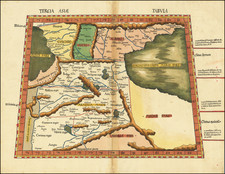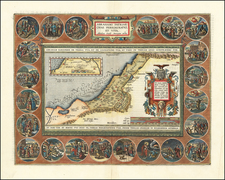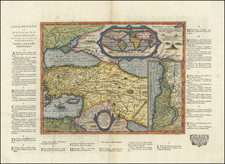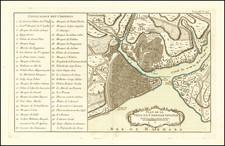Travels of Apostle Paul and other Apostles
Nice example of Stoopendahl's map of the Eastern Mediterranean, showing the Travels of the Apostles.
This decorative late 17th-century map meticulously delineates the eastern Mediterranean region, depicting the extensive travels of Apostle Paul and other Apostles as they spread the Gospel. The title translates to "The Description of the Travels of Paul and the Other Apostles with their Lands and Kingdoms where They Preached the Gospel." This piece is not merely a geographical map but a visual narrative of early Christian missionary journeys, illustrating the profound impact of these travels on the spread of Christianity.
The map encompasses the vast area stretching from Italy in the west to the regions of modern-day Turkey, Syria, and Israel in the east. Highlighting significant locations such as Cyprus, Crete, and various cities along the Mediterranean coast, it serves as a comprehensive guide to Paul's missionary routes.
Eight intricate biblical scenes adorn the borders of the map, each depicting pivotal moments from Paul's travels. These vignettes include moments of preaching, conversion, and miracles, vividly bringing to life the narrative of Paul's missionary work as documented in the Acts of the Apostles. The inclusion of these scenes serves to enhance the map's role as a didactic tool, offering both visual and textual insights into early Christian history. Each scene corresponds to a significant event in the early Christian missionary journeys, particularly those of Paul. Here is an explanation of each scene and its corresponding biblical passage:
-
Acts 2: This chapter describes the event of Pentecost, when the Holy Spirit descended upon the Apostles, enabling them to speak in various languages. This marks the beginning of the Apostles' public ministry and the spread of Christianity.
-
Acts 3:6: This verse recounts Peter healing a lame beggar at the temple gate called Beautiful. Peter says, "Silver or gold I do not have, but what I do have I give you. In the name of Jesus Christ of Nazareth, walk." This miracle demonstrates the power of faith and the early church's commitment to healing and compassion.
-
Acts 5:5: This verse refers to the story of Ananias and Sapphira. Ananias, after lying about the proceeds from the sale of his property, falls down and dies as a consequence of his deceit. This event underscores the importance of honesty and integrity within the early Christian community.
-
Acts 7:58: This passage describes the martyrdom of Stephen, the first Christian martyr. As he is stoned to death, Stephen prays for his attackers, embodying the Christian principles of forgiveness and sacrifice.
-
Acts 9:4: This verse is part of the account of Saul's (later Paul) conversion on the road to Damascus. Saul hears a voice saying, "Saul, Saul, why do you persecute me?" This pivotal moment marks Saul's transformation from a persecutor of Christians to one of Christianity's most fervent missionaries.
-
Acts 13:11: Here, Paul rebukes Elymas the sorcerer, who is struck blind as a result. Paul says, "Now the hand of the Lord is against you. You are going to be blind for a time, not even able to see the light of the sun." This miracle demonstrates the authority of the Apostles and the power of God working through them.
-
Acts 14:11: This verse describes the reaction of the people in Lystra after Paul heals a man lame from birth. The crowd exclaims, "The gods have come down to us in human form!" This event highlights the challenges Paul faced in conveying the message of monotheism in a polytheistic society.
-
Acts 20:3: In this passage, Paul is in Greece, where he stays for three months. During this time, he faces a plot against his life by some Jews, prompting him to change his travel plans. This scene reflects the constant dangers and opposition Paul encountered throughout his missionary work.
Each of these scenes is depicted on the map to illustrate key moments in the Apostolic journeys, emphasizing the trials, miracles, and teachings that defined the early spread of Christianity. The map serves not only as a geographical representation but also as a visual narrative of the profound impact of these events on the Christian faith.









![[Iskenderun] The Gulf of Alexandretta or Scandaroon](https://storage.googleapis.com/raremaps/img/small/73675.jpg)
![Turkey in Europe [Including Greece and the Balkan Peninsula]](https://storage.googleapis.com/raremaps/img/small/76200.jpg)



